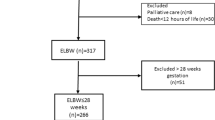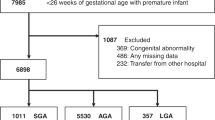Abstract
Objective:
To examine the association between weight loss during the first 10 days of life and the incidence of death or bronchopulmonary dysplasia (BPD) in small for gestational age (SGA) and appropriate for gestational age (AGA) extremely low-birth-weight infants.
Design/Methods:
This is a retrospective analysis of a cohort of ELBW (birth weight <1000 g) infants from the NICHD Neonatal Research Network's database. The cohort consisted of 9461 ELBW infants with gestational age of 24–29 weeks, admitted to Network's participating centers during calendar years 1994–2002 and surviving at least 72 h after birth. The cohort was divided into two groups, 1248 SGA (with birth weight below 10th percentile for gestational age) and 8213 AGA (with birth weight between 10th and 90th percentile) infants. We identified infants with or without weight loss during the first 10 days of life, which we termed as ‘early postnatal weight loss’ (EPWL). Univariate analyses were used to predict whether EPWL was related to the primary outcome, death or BPD, within each birth weight/gestation category (SGA or AGA). BPD and death were also analyzed separately in relation to EPWL. Logistic regression analysis was done to evaluate the risk of death or BPD in SGA and AGA groups, controlling for maternal and neonatal demographic and clinical factors found to be significant by univariate analysis.
Results:
SGA ELBW infants had a lower prevalence of EPWL as compared with AGA ELBW infants (81.2 vs 93.7%, respectively, P<0.001). In AGA infants, univariate analysis showed that death or BPD rate was lower in the group of infants with EPWL compared with infants without EPWL (53.4 vs 74.3%, respectively, P<0.001). The BPD (47.2 vs 64%, P<0.001) and death (13.8 vs 32.9%, P<0.001) rate were similarly lower in the EPWL group. The risk-adjusted odds ratios (ORs) showed that EPWL was associated with lower rate of death or BPD (OR 0.47, 95% CI: 0.37–0.60). In SGA infants, on univariate analysis, a similar association between EPWL and outcomes was seen as shown in AGA infants: death or BPD (55.9 vs 75.2%, P<0.001), BPD rate (48.3 vs 62.1%, P=0.002) and rate death (19 vs 40.8%, P<0.001) for those with or without EPWL, respectively. Multiple logistic regression showed that as in AGA ELBW infants, EPWL was associated with lower risk for death or BPD (OR 0.60, 95% CI: 0.41–0.89) among SGA infants.
Conclusions:
SGA infants experienced less EPWL when compared with their AGA counterparts. EPWL was associated with a lower risk of death or BPD in both ELBW AGA and SGA infants. These data suggest that clinicians who consider the association between EPWL and risk of death or BPD should do so independent of gestation/birth weight status.
This is a preview of subscription content, access via your institution
Access options
Subscribe to this journal
Receive 12 print issues and online access
$259.00 per year
only $21.58 per issue
Buy this article
- Purchase on Springer Link
- Instant access to full article PDF
Prices may be subject to local taxes which are calculated during checkout
Similar content being viewed by others
References
Donovan EF, Ehrenkranz RA, Shankaran S, Stevenson DK, Wright LL, Younes N et al. Outcomes of very low birth weight twins cared for in the National Institute of Child Health and Human Development Neonatal Research Network's intensive care units. Am J Obstet Gynecol 1998; 179: 742–749.
Friis-Hansen B . Changes in body water compartments during growth. Acta Paediatr 1957; 46: 1–68.
Singhi S, Sood V, Bhakoo ON, Ganguly NK, Kaur A . Composition of postnatal weight loss & subsequent weight gain in preterm infants. Indian J Med Res 1995; 101: 157–162.
Stonestreet BS, Bell EF, Warburton D, Oh W . Renal response in low-birth-weight neonates. Results of prolonged intake of two different amounts of fluid and sodium. Am J Dis Child 1983; 137: 215–219.
Shaffer SG, Bradt SK, Hall RT . Postnatal changes in total body water and extracellular volume in the preterm infant with respiratory distress syndrome. J Pediatr 1986; 109: 509–514.
Oh W, Poindexter BB, Perritt R, Lemons JA, Bauer CR, Ehrenkranz RA et al. Association between fluid intake and weight loss during first ten days of life and risk of bronchopulmonary dysplasia in extremely low birth weight infants. J Paediatr 2005; 147: 786–790.
Bauer K, Cowett RM, Howard GM, vanEpp J, Oh W . Effect of intrauterine growth retardation on postnatal weight change in preterm infants. J Pediatr 1993; 123: 301–306.
Hartnoll G, Betremieux P, Modi N . Body water content of extremely preterm infants at birth. Arch Dis Child Fetal Neonatal Ed 2000; 83: F56–F59.
vd Wagen A, Okken A, Zween J, Zijlstra W . Composition of postnatal weight loss and subsequent weight gain in small for dates newborn infants. Acta Paediatr Scand 1985; 74: 57–61.
Larciprete G, Valensise H, Di Pierro G, Vasapollo B, Casalino B, Arduini D et al. Intrauterine growth restriction and fetal body composition. Ultrasound Obstet Gynecol 2005; 26: 258–262.
Alexander G, Himes J, Kaufman R, Mor J, Kogan M . A United States national reference for fetal growth. Obst &Gynec 1996; 87: 163–168.
Walsh MC, Yao Q, Gettner P, Hale E, Collins M, Hensman A et al. Impact of a physiologic definition on bronchopulmonary dysplasia rates. Pediatrics 2004; 114: 1305–1311.
Chessex P, Reichman B, Verellen G, Putet G, Smith JM, Heim T et al. Metabolic consequences of intrauterine growth retardation in very low birthweight infants. Pediatr Res 1984; 18: 709–713.
Abdulrazzaq YM, Brooke OG . Is the raised metabolic rate of the small for gestation infant due to his relatively large brain size. Early Hum Dev 1988; 16: 253–261.
Stevenson JG . Fluid administration in the association of patent ductus arteriosus complicating respiratory distress syndrome. J Pediatr 1977; 90: 257–261.
Bell EF, Warburton D, Stonestreet BS, Oh W . Effect of fluid administration on the development of symptomatic patent ductus arteriosus and congestive heart failure in premature infants. N Engl J Med 1980; 302: 598–604.
Bell EF, Warburton D, Stonestreet BS, Oh W . High volume fluid intake predisposes premature infants to necrotizing enterocolitis. Lancet 1979; 2: 90.
Brown ER, Stark A, Sosenko I, Lawson EE, Avery ME . Bronchopulmonary dysplasia: possible relationship to pulmonary edema. J Pediatr 1978; 92: 982–984.
Van Marter LJ, Leviton A, Allred EN, Pagano M, Kuban KC . Hydration during the first days of life and the risk of bronchopulmonary dysplasia in low birth weight infants. J Pediatr 1990; 116: 942–949.
Kavvadia V, Greenough A, Dimitriou G, Hooper R . Randomised trial of fluid restriction in ventilated very low birthweight infants. Arch Dis Child Fetal Neonatal Ed 2000; 83: F91–F96.
Lorenz JM, Kleinman LI, Kotagal UR, Reller MD . Water balance in very low-birth-weight infants: relationship to water and sodium intake and effect on outcome. J Pediatr 1982; 101: 423–432.
Author information
Authors and Affiliations
Corresponding author
Appendix A
Appendix A
Members of the NICHD Neonatal Research Network
Alan Jobe, MD, Chairman
University of Cincinnati
Case Western Reserve University (U10 HD21364)
Michele Walsh, MD*
Avroy A Fanaroff, MB, BCh
Nancy Newman, RN
University of Cincinnati (U10 HD27853)
Edward F Donovan, MD*
Vivek Narendran MD, MRCP
Marcia Mersmann, RN
Emory University (U10 HD27851)
Barbara J Stoll, MD*
Ellen Hale, RN
Indiana University (U10 HD27856)
James A Lemons, MD*
Brenda Poindexter, MD
Diana Appel, RN
University of Miami (U10 HD21397)
Shahnaz Duara, MD*
Charles R Bauer, MD
Ruth Everett, RN
University of New Mexico (U10 HD27881)
Lu-Ann Papile, MD*
Conra Backstrom, RN
Stanford University (U10 HD27880)
David K Stevenson, MD*
Krisa Van Meurs, MD
Bethany Ball, BS
University of Tennessee at Memphis (U10 HD21415)
Sheldon B Korones, MD*
Henrietta Bada, MD
Tina Hudson, RN
University of Texas Southwestern Medical Center (U10 HD40689)
Abbot R Laptook, MD*
Walid Salhab, MD
Gay Hensley, RN
University of Texas – Houston (U10 HD21373)
Jon E Tyson, MD, MPH*
Kathleen Kennedy, MD, MPH
Susie Madison, RN
Wayne State University (U10 HD21385)
Seetha Shankaran, MD*
Ganesh Konduri, MD
Geraldine Muran, RN
Women and Infants Hospital (U10 HD27904)
William Oh, MD*
Barbara Stonestreet, MD
Angelita Hensman, RN
Yale University (U10 HD27871)
Richard A Ehrenkranz, MD*
Patricia Gettner, RN
University of Alabama at Birmingham (U10 HD34216)
Waldemar A Carlo, MD*
Namasivayam Ambalavanan, MD
Monica V Collins, RN
Harvard University (U10 HD34167)
Ann R Stark, MD*
Kerri Fournier, RN
Duke University (U10 HD40492)
Ronald N Goldberg, MD*
Michael Cotten, MD
Kathy Auten, BS
Wake Forest University (U10 HD40498)
T. Michael O'Shea, MD*
Robert Dillard, MD
Nancy Peters, RN
University of Rochester (U10 HD40521)
Dale L. Phelps, MD*
Ronnie Guillet, MD, PhD
Linda Reubens, RN
University of California at San Diego (U10 HD40461)
Neil N Finer, MD*
Maynard Rassmussen, MD
Wade Rich, BS, RRT
Research Triangle Institute (U01 HD36790)
Abhik Das, PhD*
W Kenneth Poole, PhD
Betty Hastings
Carolyn M. Petrie
National Institute of Child Health and Human Development
Rosemary Higgins, MD
Linda L Wright, MD
James Hansen, MD
*Principal Investigator
Rights and permissions
About this article
Cite this article
Wadhawan, R., Oh, W., Perritt, R. et al. Association between early postnatal weight loss and death or BPD in small and appropriate for gestational age extremely low-birth-weight infants. J Perinatol 27, 359–364 (2007). https://doi.org/10.1038/sj.jp.7211751
Received:
Revised:
Accepted:
Published:
Issue Date:
DOI: https://doi.org/10.1038/sj.jp.7211751
Keywords
This article is cited by
-
Risk factors and epidemiology of spontaneous intestinal perforation among infants born at 22–24 weeks’ gestational age
Journal of Perinatology (2024)
-
Correlation between early postnatal body weight changes and lung ultrasound scores as predictors of bronchopulmonary dysplasia in preterm infants: A secondary analysis of a prospective study
European Journal of Pediatrics (2024)
-
Neonatal fluid overload—ignorance is no longer bliss
Pediatric Nephrology (2023)
-
Postnatal maximal weight loss, fluid administration, and outcomes in extremely preterm newborns
Journal of Perinatology (2022)
-
Individualized fluid management in extremely preterm neonates to ensure adequate diuresis without increasing complications
Journal of Perinatology (2021)



